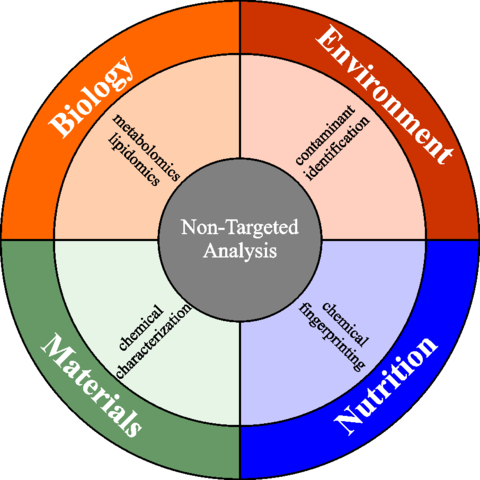Summary
The MANTA Program is an ongoing collaboration with laboratories to increase the comparability and reproducibility of their results using non-targeted analysis techniques, with a specific focus on instrumental techniques and subsequent data analysis. Collaborators include laboratories from academia, government and industry that currently apply non-targeted analytical tools, or are interested in establishing a non-targeted analysis program. The program includes reference material creation, interlaboratory studies, and novel computational tool development. Initially, the program will focus on the use of liquid chromatography with mass spectrometry for non-targeted analysis, with the intent of expanding the program to other techniques.
Description

Typical targeted analysis aims to detect and/or quantify a set of known chemical compounds using specific instrumental techniques (such as liquid chromatography with triple quadrupole mass spectrometry). In contrast, non-targeted analysis is an analytical technique that detects, identifies, and/or quantifies a broad range of unknown chemical compounds without specifically targeting individual compounds. Non-targeted analytical techniques often use advanced instrumentation, such as high-resolution mass spectrometers and nuclear magnetic resonance (NMR) spectrometers, coupled with data analysis tools. Non-targeted analysis is a key part of many emerging research fields, including many of the “omics” approaches (e.g., metabolomics).
OBJECTIVE
With the rapid development of non-targeted techniques, there is a significant need for tools to understand non-targeted analysis results, compare results between laboratories, and provide quality control of non-targeted analysis protocols. The purpose of the MANTA program is to create reference materials and data that can be used evaluate non-targeted analysis results, as well as initiate and lead discussions with practitioners regarding quality assurance and quality control (QA/QC) of non-targeted analytical methods. The materials and data will be produced internally and using interlaboratory studies that engage members of the non-targeted analysis communities.
CURRENT ACTIVITY
Currently, we are planning for the first interlaboratory study between non-targeted analysis laboratories to evaluate a new tool for comparing non-targeted analysis results using liquid chromatography with high resolution mass spectrometry. There will be a recorded informational webinar on March 21st, 2018, at 2:00 PM, to be included in the webinar, please contact manta [at] nist.gov (manta[at]nist[dot]gov). For more information about the MANTA program, please click: manta information.
CONTACT
MANTA Program Coordinators, manta [at] nist.gov (manta[at]nist[dot]gov)
Publications
1. Quinete, N., Du, B. W., Furlong, E., Place, B., Ulrich, E. M., and Anumol, T., "Special Section: Advances in Methodology and Applications of Nontargeted Analysis in Environmental Monitoring," Environmental Toxicology and Chemistry, 41, 1115-1116 (2022).
2. Place, B. J., "Development of a Data Analysis Tool to Determine the Measurement Variability of Consensus Mass Spectra," Journal of the American Society for Mass Spectrometry, 32, 707-715 (2021).
3. Renaguli, A., Fernando, S., Holsen, T. M., Hopke, P. K., Adams, D. H., Balazs, G. H., Jones, T. T., Work, T. M., Lynch, J. M., and Crimmins, B. S., "Characterization of Halogenated Organic Compounds in Pelagic Sharks and Sea Turtles Using a Nontargeted Approach," Environ. Sci. Technol., 55, 16390-16401 (2021).
4. Cruz, M. B., Place, B. J., Wood, L. J., Urbas, A., Wasik, A., and Rocha, W. F. D., "A nontargeted approach to determine the authenticity ofGinkgo bilobaL. plant materials and dried leaf extracts by liquid chromatography-high-resolution mass spectrometry (LC-HRMS) and chemometrics," Analytical and Bioanalytical Chemistry, 412, 6969-6982 (2020).

